The Monitoring Group of BlackSeaNews
and the Black Sea Institute of Strategic Studies
The analysis has been made based on the database of legal entities subject to sanctions in connection with Russian aggression against Ukraine, maintained by the Monitoring Group of the Black Sea Institute of Strategic Studies since the beginning of Russian aggression.
The database contains legal entities subject to sanctions imposed by:
- Ukraine,
- the USA,
- the EU,
- the UK,
- and Canada.
The database is constantly updated. Since the beginning of the Russian full-scale invasion, it has been updated very frequently due to a significant increase in the number of sanctions. Data as of 1 September 2023 have been used for the analysis.
Updating the database is not a mechanical process of transferring information from sanctions lists. We try to accurately identify legal entities. Sometimes, due to the lack of information in the sanctions lists or errors that occasionally occur there, the identification process is quite difficult. In some cases, it is possible only after the correction of errors in the list by the body that has introduced sanctions.
When necessary and possible, we add important information on a legal entity’s addresses, registration and tax data, linked entities, etc.
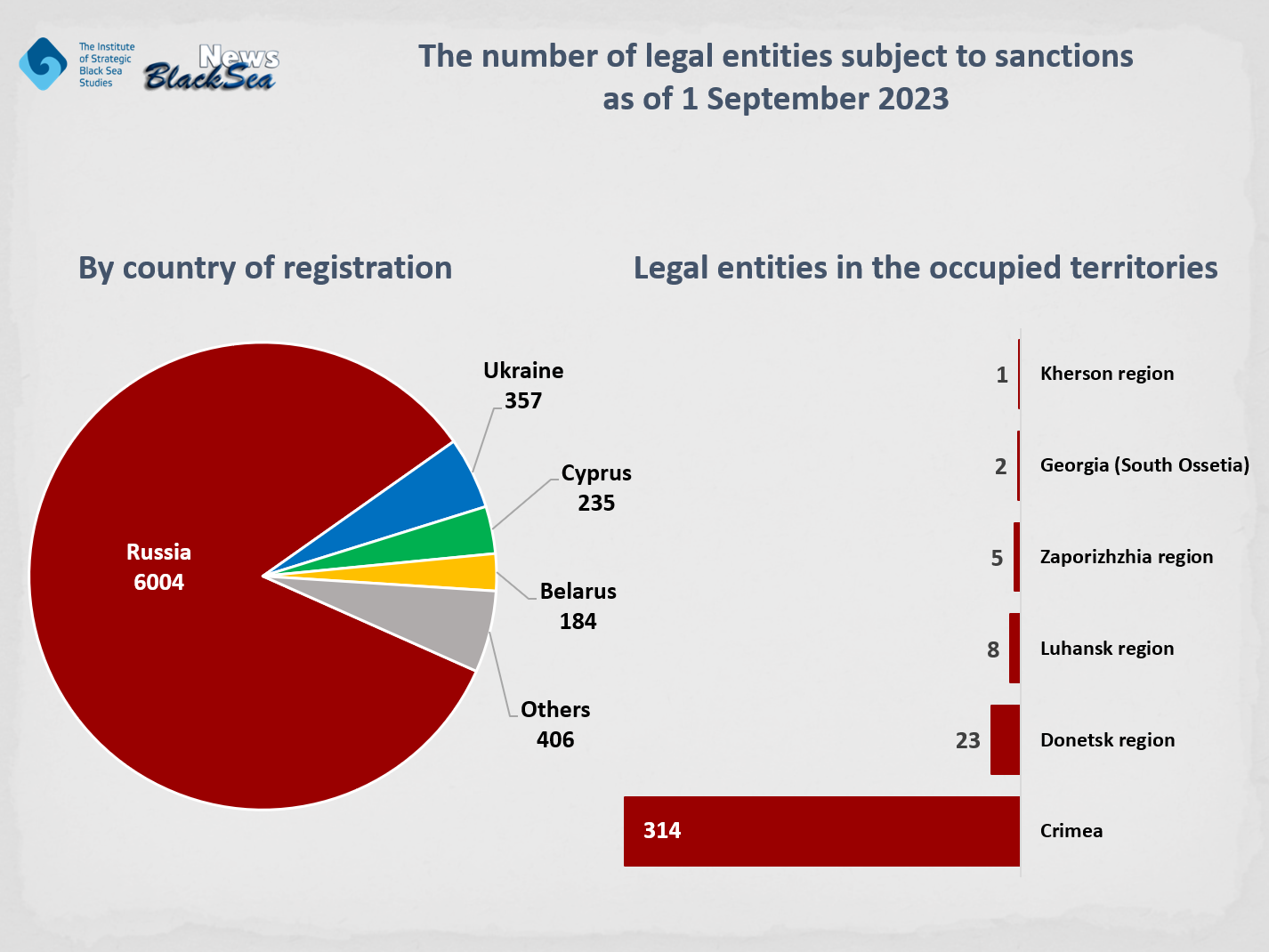
In total, as of 1 September 2023, the database contained 7,186 legal entities, the vast majority of which – 6,004 (83%) – were Russian. 353 legal entities were registered in the occupied territories of Ukraine (351) and Georgia (2).
Our database is not only a list of companies that are currently under sanctions. It contains the entire history of decisions on the imposition (or lifting) of sanctions on each entity, as well as changes in their names, legal status, etc. Reorganisation and liquidation of legal entities, being in a state of bankruptcy, presence or absence of an official legal successor or managing organisation – we try to track all of these in a timely manner.
The following figures show the number of sanctions against legal entities by state that has imposed them.
Sanctions against the largest number of enterprises (6,388) have been introduced by Ukraine. US sanctions apply to 2,081 enterprises. Other states have imposed far fewer sanctions.
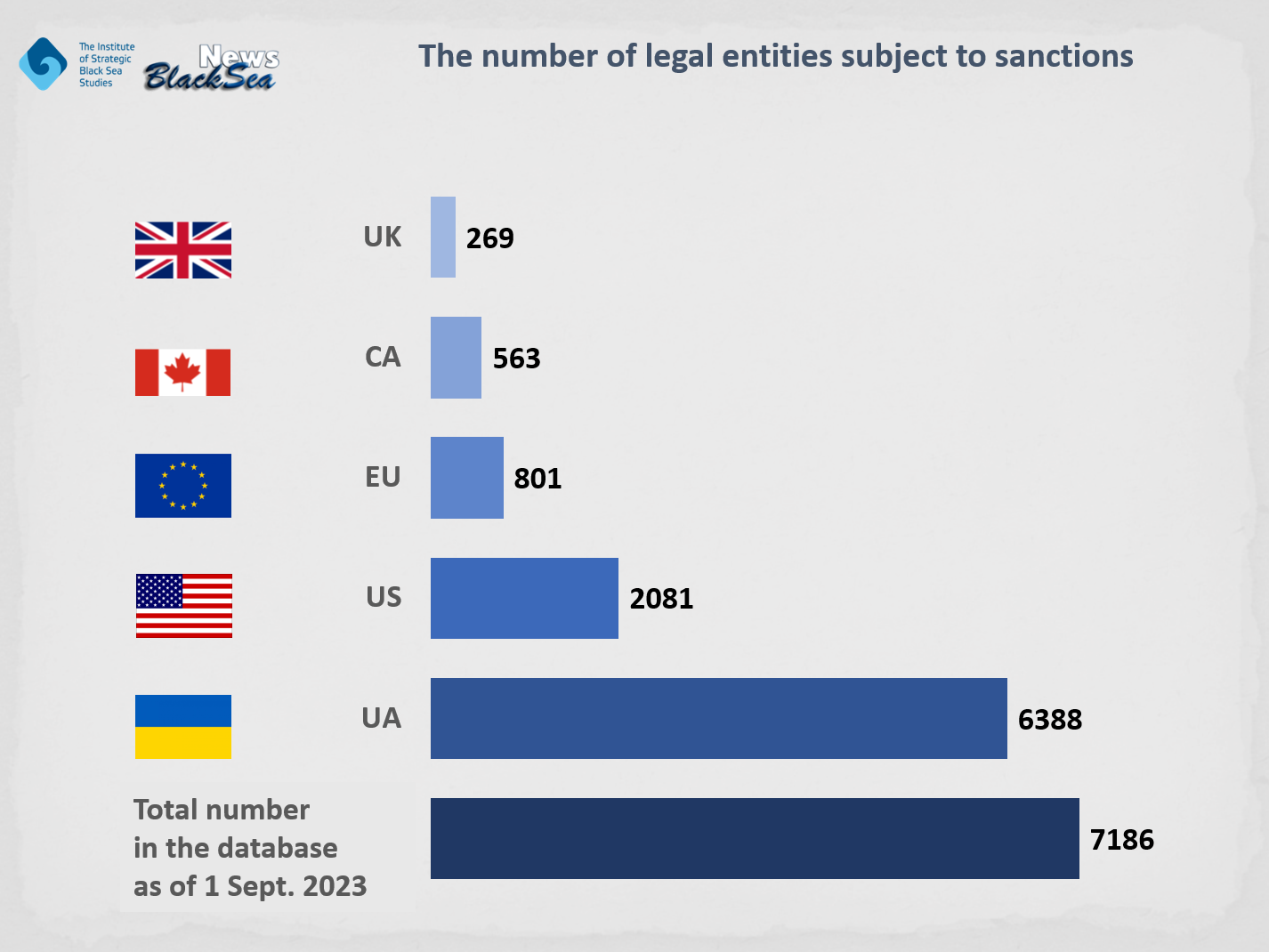
Looking at Figure 3, which shows all combinations of sanctions, we can see that only Ukrainian sanctions have been imposed against 4.8 thousand enterprises.
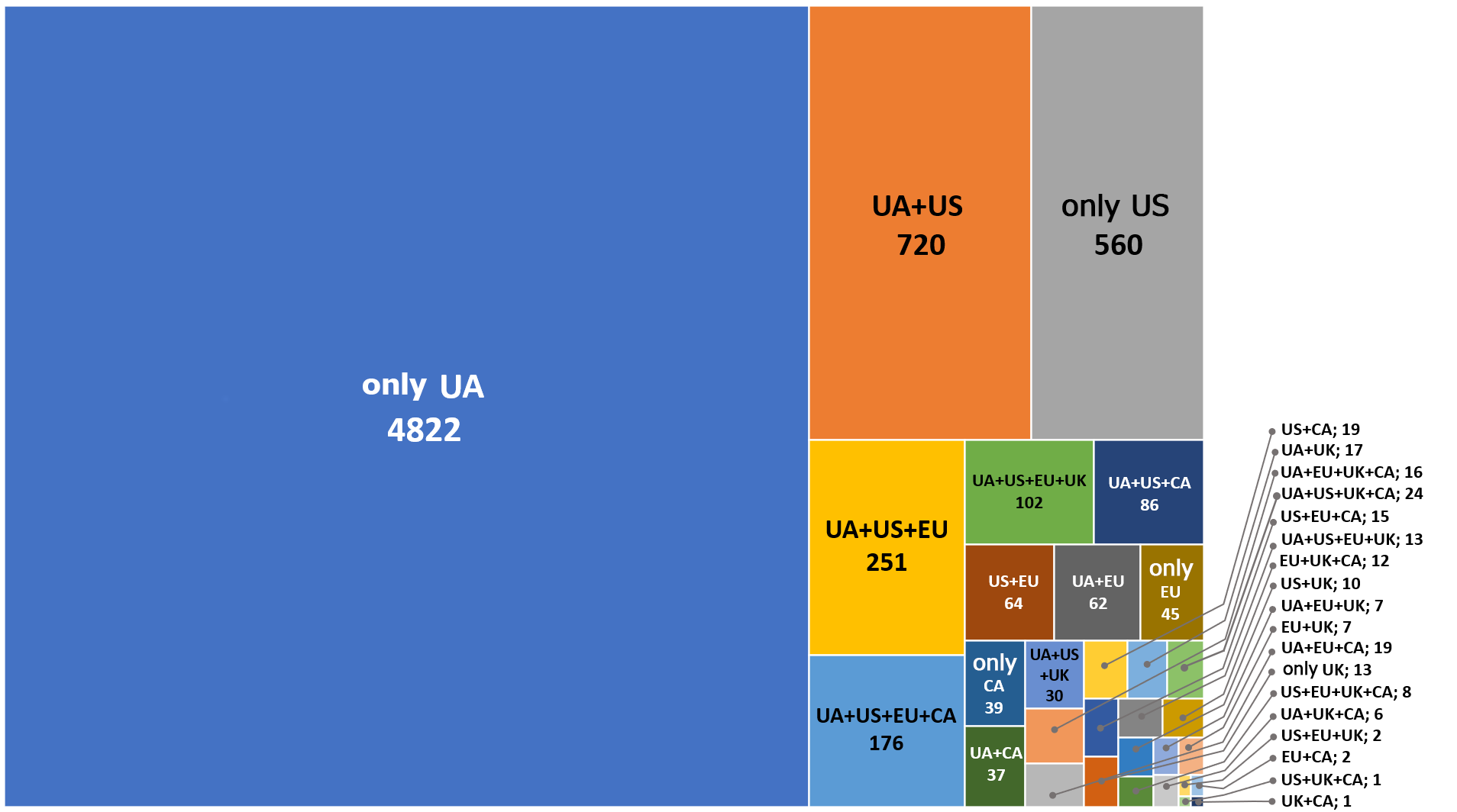
Ukraine’s sanctions
The database includes all legal entities listed in Decrees of the President of Ukraine on sanctions against legal entities since September 2015.
There were different periods in Ukraine’s sanctions policy, and we regularly wrote about problems related to it.
For example, the delay in the introduction of sanctions seemed incomprehensible. The first decision on the imposition of sanctions was adopted by the National Security and Defenсe Council (NSDC) only on 2 September 2015, despite the fact that the first US and EU decisions appeared as early as March 2014, and the corresponding basic law of Ukraine On Sanctions was passed on 14 August 2014.
The listing of new entities was very slow. Some of them (such as the subsidiaries of Russian banks in Ukraine) appeared on the lists only after numerous protest actions. There was a lot of talk about the need to synchronise Ukrainian sanctions with the international community.
Some companies that had been subject to sanctions were later removed from Ukrainian sanctions lists (sanctions were simply not extended after their expiration). There were also errors in the lists that partially nullified the effect of sanctions.
Moreover, what makes it impossible for anyone to work effectively with the list of entities under sanctions is the lack of the official state database of sanctions. All lists are scattered in dozens of separate annexes to the decisions of the NSDC. This problem remains relevant today.
The situation began to change some time after Russia’s full-scale invasion. Since the end of 2022, the number of Ukrainian sanctions has increased dramatically and the quality of work with the lists has improved.
Some errors in the decisions still occur. Not all of the legal entities “lost” in previous years have returned to the sanctions lists. There are several enterprises against which sanctions expired on 19 March 2022. There are some important ones among them.
For example,
Profkhim LLC (Ufa, Russia), which supplies products to Tambov Gunpowder Plant, Perm Gunpowder Plant, Russian Concern for the Production of Electric and Thermal Energy at Nuclear Power Plants (Rosenergoatom), ODK-Saturn, and Votkinskiy Zavod.
S. T. Technology LLC (Saint Petersburg, Russia) is the supplier of Yaroslavl Shipyard, Admiralty Shipyard JSC, and Vympel Shipyard.
Industrialnyye i Morskiye Proyekty LLC, which provides maintenance services for ship engines. The list of its partners on the website (for visitors with a Russian IP) indicates German Bosch, Marine Motor Service, Spanish Detegasa, Finnish WE Tech, British Simplex-Turbulo, and other Western companies.
Sevastopol Central Design Bureau Corall, which after the occupation of Crimea became part of United Shipbuilding Corporation.
13th Shipyard of the Black Sea Fleet of the Ministry of Defence of the Russian Federation in Sevastopol, which needs no further comment.
However, we should note that in general, despite all the shortcomings and the problems inherent in the martial law, the introduction of sanctions by Ukraine has become more active.
In 2022-23, more than 4,500 new legal entities were added to the Ukrainian list, in particular, 3,100 in 2023, the vast majority of which are enterprises of the Russian military-industrial complex and those related to the military industry.
The process of synchronising sanctions has been significantly accelerated. Legal entities subject to sanctions from other states appear on Ukrainian lists quite promptly.
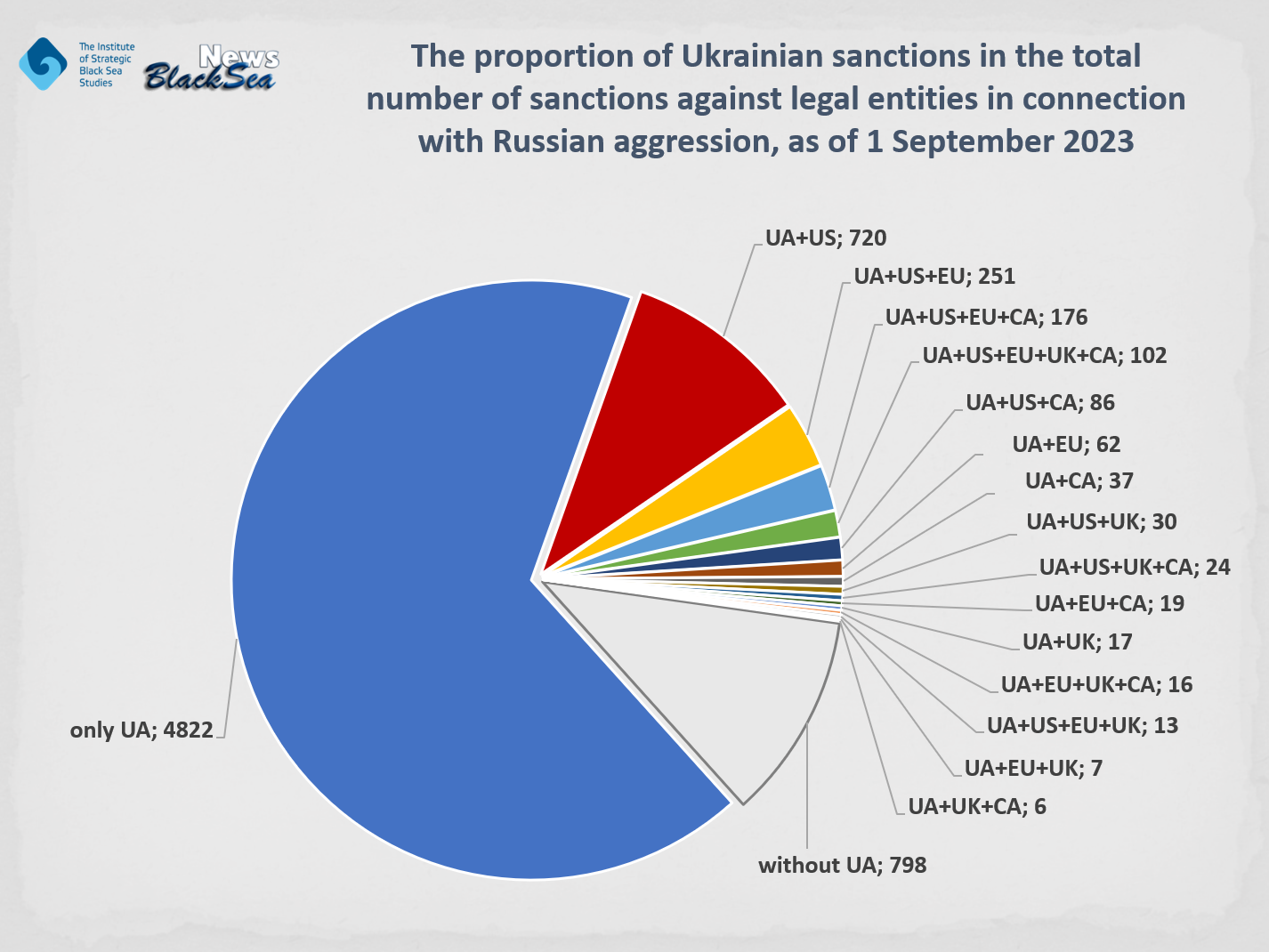
As of 1 September 2023, only Ukrainian sanctions were imposed on 4,822 legal entities (this is 67% of the total number of legal entities in the database).
It is clear that Ukrainian sanctions during the “hot phase” of the war do not make much economic sense, because cooperation with any Russian enterprises is impossible and unacceptable now. And when such facts are revealed, they are classified as a criminal offence.
The main role of Ukraine’s sanctions against Russian legal entities today is to inform our partners in the “sanctions coalition” that they should also impose sanctions against these enterprises.
Partner countries are provided with relevant information immediately after official decisions have been made.
Currently, it is Ukraine that expects its partners to synchronise the lists.
US sanctions
The database contains all legal entities from the SDN, SSI, CAPTA lists of the Office of Foreign Assets Control (OFAC) of the US Treasury Department under sanctions programs related to Russian aggression against Ukraine:
- UKRAINE-EO13660 (Executive Order 13660)
- UKRAINE-EO13661 (Executive Order 13661)
- UKRAINE-EO13662 (Executive Order 13662)
- UKRAINE-EO13685 (Executive Order 13685)
- RUSSIA-EO14024 (Executive Order 14024)
- RUSSIA-EO14065 (Executive Order 14065)
- BPI-RUSSIA-EO14024 (Blocked Pending Investigation, Russian Harmful Foreign Activities Sanctions Regulations, 31 CFR Part 587)
- BELARUS (Belarus Sanctions Regulations, 31 C.F.R. part 548; Executive Order 13405)
- BELARUS-EO14038 (Executive Order 14038)
However, the range of legal entities in the database is not limited to “Russian-Ukrainian” programs. Over time, more and more companies that are included in other US sanctions programs prove to be in one way or another connected with Russian aggression against Ukraine.
Therefore, legal entities from the following OFAC programs can also be found in the database:
- CAATSA-RUSSIA (Countering America’s Adversaries Through Sanctions Act of 2017)
- CAR (Central African Republic Sanctions, 31 C.F.R. part 553)
- CYBER2 (Executive Order 13694; Executive Order 13757)
- DPRK3 (Executive Order 13722)
- ELECTION-EO13848 (Executive Order 13848)
- GLOMAG (Executive Order 13818 – Global Magnitsky)
- IFSR (Iranian Financial Sanctions Regulations, 31 CFR part 561)
- IRAN-CON-ARMS-EO (Executive Order 13949)
- IRGC (Iranian Financial Sanctions Regulations, 31 CFR Part 561)
- NPWMD (Weapons of Mass Destruction Proliferators Sanctions Regulations, 31 C.F.R. part 544)
- PEESA-EO14039 (Executive Order 14039)
- SDGT (Global Terrorism Sanctions Regulations, 31 C.F.R. part 594)
- SYRIA (Executive Order 13338; EO 13399; EO 13460; EO 13572; EO 13573; EO 13582)
- TCO (Transnational Criminal Organizations Sanctions Regulations, Executive Order 13581)
- VENEZUELA-EO13850 (Executive Order 13850)
Separately, the database identifies legal entities subject to US export controls.
These are enterprises included in the Entity List (EL) and Military End User List (MEU List) of the Bureau of Industry and Security (BIS) of the US Department of Commerce.
Figure 5 shows all entities in the database subject to any US sanctions (OFAC and/or BIS).
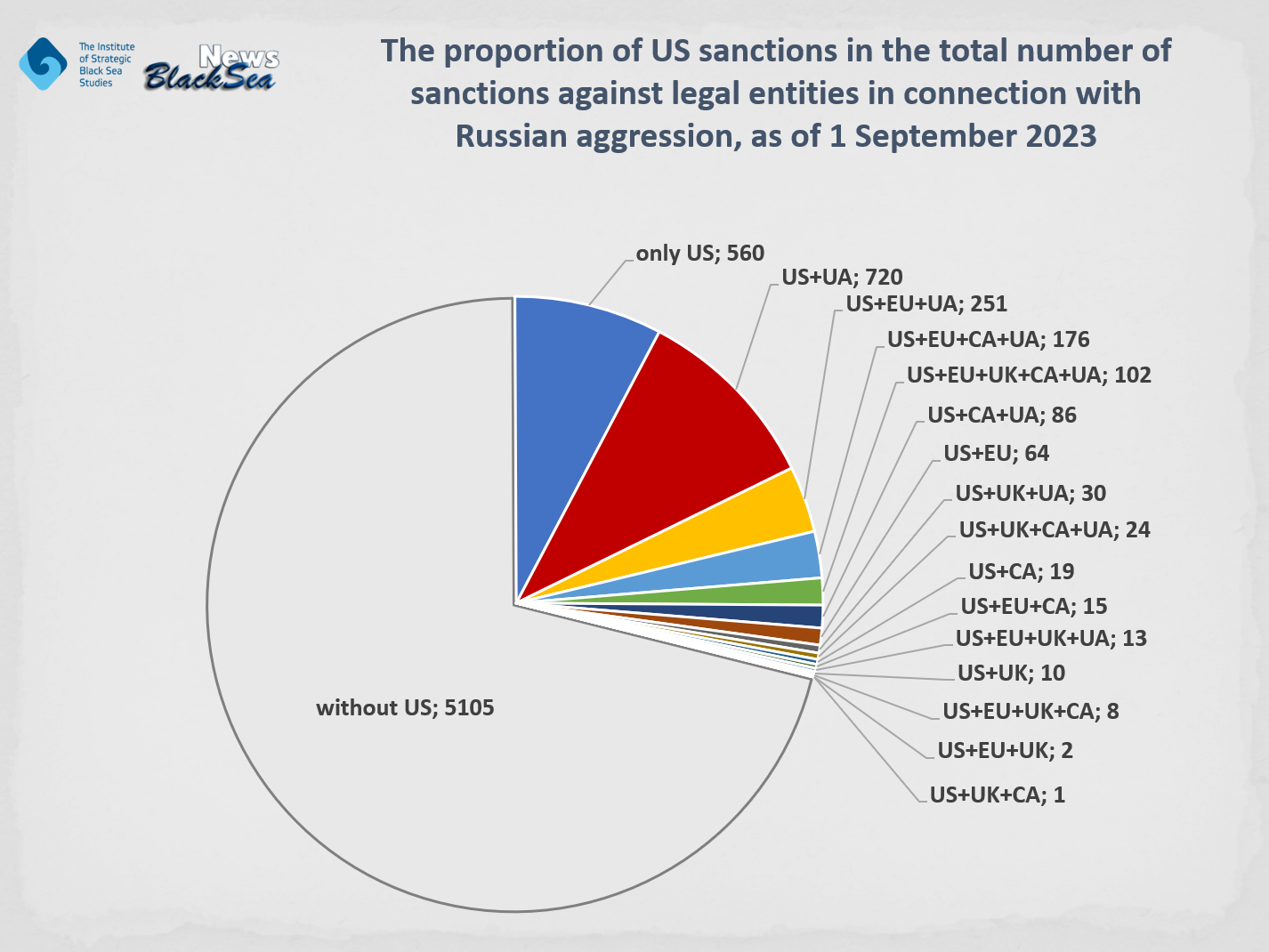
Despite the significant number of American sanctions and their importance for maintaining and strengthening the sanctions pressure on Russia, many legal entities should still be added to the US sanctions lists.
One of the main objectives of the sanctions against the Russian Federation is to impede the operations of its military-industrial complex, to make it impossible to produce modern weapons in quantities sufficient for waging war.
An important role in this is played by general export controls on the supply of military and dual-purpose goods to Russia (more on this in our next article).
However, no less important is the inclusion of all Russian military-industrial complex enterprises on the sanctions lists of all the countries of the “sanctions coalition.” And it is the US sanctions that set an example for partners to follow.
Below are just a few examples of enterprises against which Ukrainian sanctions have been imposed while US sanctions have not yet been applied.
Research Institute of Command Devices JSC, which develops instruments for navigation and motion control of rockets, launch vehicles, and spacecraft. The company also produces component blocks for the Bars-M (14F148) military reconnaissance satellite and the Lotos-S (OM14F145) military electronic intelligence satellite and supplies components for the production of missile weapons.
Aviaagregat JSC, which manufactures unguided aircraft missile launchers for aircraft and helicopters of the Russian Aerospace Forces, hydraulic cylinders and hydraulic jacks for anti-aircraft missile systems.
Tulamashzavod JSC, which produces a wide range of small arms, automatic cannons, air defence and anti-aircraft missile systems, and high-precision munition.
Aerocon JSC, Aerocon LLC, which produce unmanned aerial vehicles (UAVs) and complexes with UAVs.
99 Plant of Aviation Technological Equipment JSC, which is part of Russian Helicopters holding, repairs on-board equipment of the Il-76, Il-78, Tu-22M3 military aircraft of the Russian Aerospace Forces.
Izumrud JSC, which is part of Concern Morinformsystem-Agat JSC, develops the MP-123-02/3 Bagira fire-control systems, fulfils orders for the Russian Defence Ministry, cooperates with the enterprises of the military-industrial complex in the repair of radar equipment of the Russian Navy.
Special Design Bureau of Transport Mechhanical Engineering JSC, the developer and manufacturer of armoured vehicles, artillery materiel, and engineer vehicles for the Russian Armed Forces.
Zavod № 9 JSC – the main developer and one of the manufacturers of 125-mm tank guns for the main tanks T-14, T-80, and T-90, the 125-mm guns 2A75 and 2S25, the howitzers 2A64 and D30A, RBU1000 and RBU6000.
Federal State Enterprise Perm Gunpowder Plant, 82 Ship Repair Plant JSC, 81 Armored Repair Plant JSC and many others.
EU sanctions
EU sanctions are regulated by several basic Council Decisions and relevant Council Regulations, which are amended when new sanctions packages are adopted.
The database contains all legal entities subject to EU sanctions in connection with Russian aggression, according to the following Council Regulations:
- №269/2014 of 17 March 2014 concerning restrictive measures in respect of actions undermining or threatening the territorial integrity, sovereignty and independence of Ukraine;
- № 692/2014 of 23 June 2014 concerning restrictive measures in response to the illegal annexation of Crimea and Sevastopol;
- № 833/2014 of 31 July 2014 concerning restrictive measures in view of Russia’s actions destabilising the situation in Ukraine.
In addition, the database contains Belarusian and Russian legal entities subject to EU sanctions in connection with cyber attacks and human rights violations. These entities have been listed according to the following Council Regulations:
- № 765/2006 of 18 May 2006[1] concerning restrictive measures in view of the situation in Belarus and the involvement of Belarus in the Russian aggression against Ukraine;
- № 2019/796 of 17 May 2019 concerning restrictive measures against cyber-attacks threatening the Union or its Member States;
- № 2020/1998 of 7 December 2020 concerning restrictive measures against serious human rights violations and abuses.
[1] The year 2006 is not a mistake. The document, adopted in May 2006, “concerning restrictive measures against President Lukashenko and certain officials of Belarus” introduced sanctions against individuals. Later, it was renamed and extended to include persons (in particular, legal entities) that participated in the Russian aggression.
Despite the fact that as early as December 2022, some European officials began to say that EU sanctions had already “reached their ceiling,” Figures 2 and 6 show that legal entities under European sanctions, unfortunately, account for only 11% of the total number of legal entities against which sanctions have been imposed.
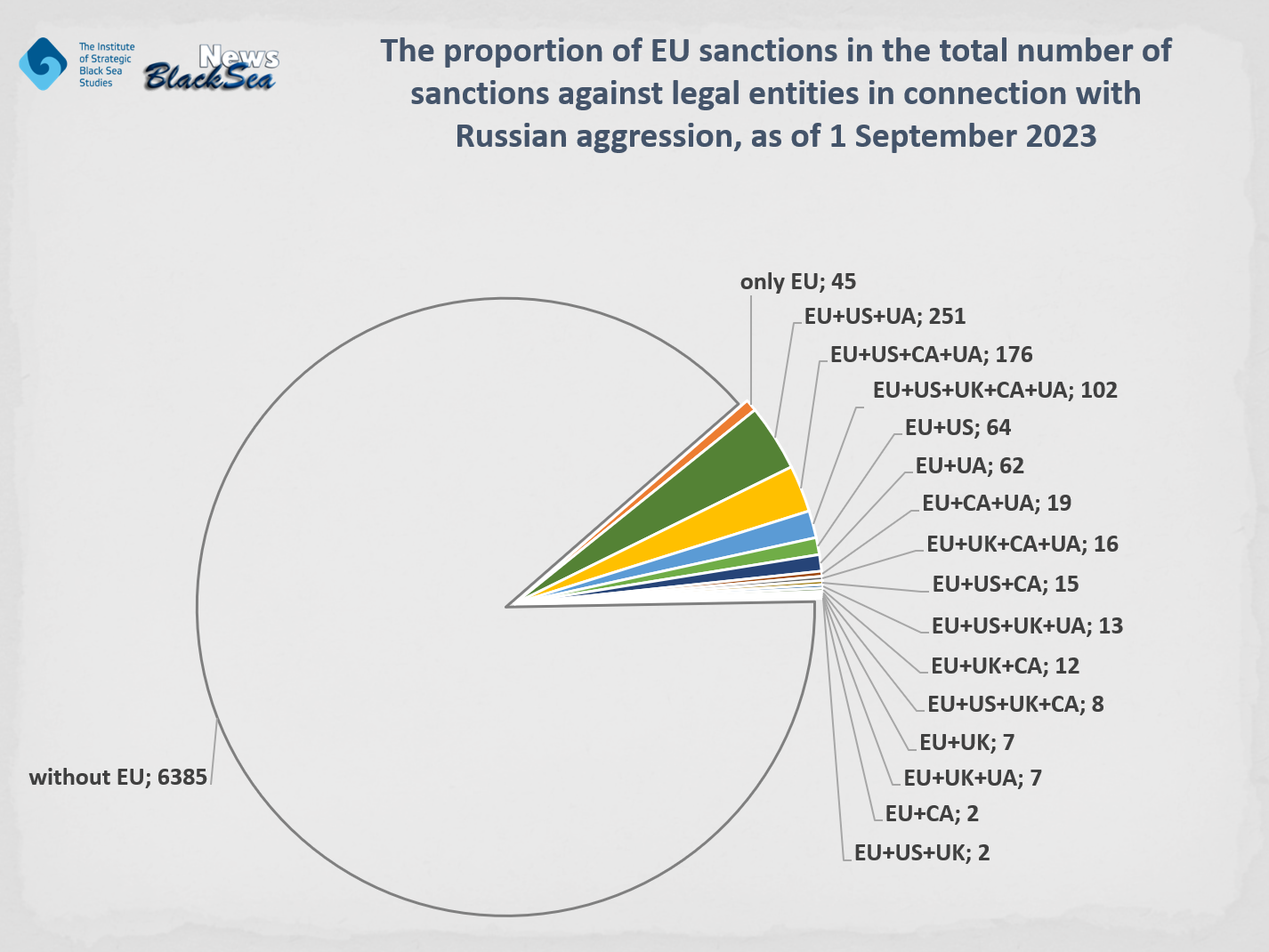
European Commissioner Virginius Sinkevičius stated on 22 December 2022: “I said a long time ago that the sanctions had reached their ceiling and there can be no innovations in these sanctions… I do not see areas where something new can be added to these sanctions. When you look realistically at these core areas, when it comes to the Russian economy, this noose is pretty tight…”
In April 2023, before the introduction of the 11th package of sanctions, the article in Financial Times stated that in the EU it was assumed that the sanctions against Russia had probably reached their ceiling. An unnamed European official was quoted as saying: “We are finished. If we introduce more sanctions, there will be more exceptions than measures.”
Another problem with European sanctions against Russian enterprises is the difficulty of identifying companies under EU sanctions.
A number of annexes to Regulation (EU) No. 833/2014 contain legal entities subject to restrictions.
For example, Annex IV lists enterprises that are military end-users, form part of Russia’s military-industrial complex or that have commercial or other links with or that otherwise support Russia’s defence and security sector.
Unfortunately, these enterprises are represented only by names.
– Firstly, it raises a lot of questions regarding the identification of such legal entities even when adding new companies to the database.
For example, in December 2022, NPP Start was added to Regulation (EU) No. 833/2014. In the Annex, it looks as follows: NPP Start (Russia).
In the Russian Register of Legal Entities, one can find at least 6 active enterprises under the same name NPP Start, which are located in Yekaterinburg, Novosibirsk, Perm, Taganrog, and small towns of the Tyumen and Sverdlovsk regions. They include a joint-stock company and 5 limited liability companies.
We have managed to identify the legal entity as NPP Start Im. A. I. Yaskina.
Will those who have to implement or monitor the implementation of sanctions be able to do it?
One more example is Proton JSC, which was added to the Annex of Council Regulation (EU) No. 833/2014 on 23 June 2023.
There are 5 active companies under the name Proton JSC in the Russian registry: in the Republic of Tatarstan, St. Petersburg, the city of Oryol, and two in Moscow.
– Secondly, this gives such legal entities the opportunity to circumvent sanctions very quickly and easily. To do this, they only need to change the name, even without reorganising the legal entity.
For example, before being renamed on 11 January 2023, JSC Special Design Bureau of the RF Ministry of Defence was called AO 766 Upravleniye Proizvodstvenno-Tekhnologicheskoy Komplektatsii (Joint Stock Company 766 UPTK). It was under this name (Joint Stock Company 766 UPTK) that it was added to Regulation (EU) No. 833/2014 on 16 December 2022.
At the moment, the enterprise included in the sanctions list appears to be no longer there, because there are no signs other than the name that could help identify it.
Joint Stock Company 218 Aviation Repair Plant (218 ARZ), after being renamed on 21 October 2022, has the name JSC UEC-Service. On 16 December 2022, it was added to Regulation (EU) No. 833/2014 as Joint Stock Company 218 Aviation Repair Plant (218 ARZ).
It sometimes happens that a company is added to the lists under the old name, because the documents for sanctions are prepared for a long time and the accuracy of the data is not always verified at the moment of placing an entity on sanctions lists. Usually, this is unpleasant, but not critical, because there are also an address, registration and tax numbers. But, unfortunately, it does not work in the case of annexes to Regulation (EU) No. 833/2014.
In our opinion, EU sanctions are still far from the “ceiling” and need to be tightened. They will also not be effective without strengthening control over their implementation and improving the procedure of drawing up decisions on sanctions.
Canadian sanctions
The database contains legal entities subject to sanctions according to Special Economic Measures Regulations adopted in 2014-2020 under the Special Economic Measures Act.
- Special Economic Measures (Russia) Regulations , 2014-03-17
- Special Economic Measures (Belarus) Regulations, 2020-09-28
- Special Economic Measures (Ukraine) Regulations, 2014-03-17. These are sanctions concerning the occupied territories and persons involved in the occupation.
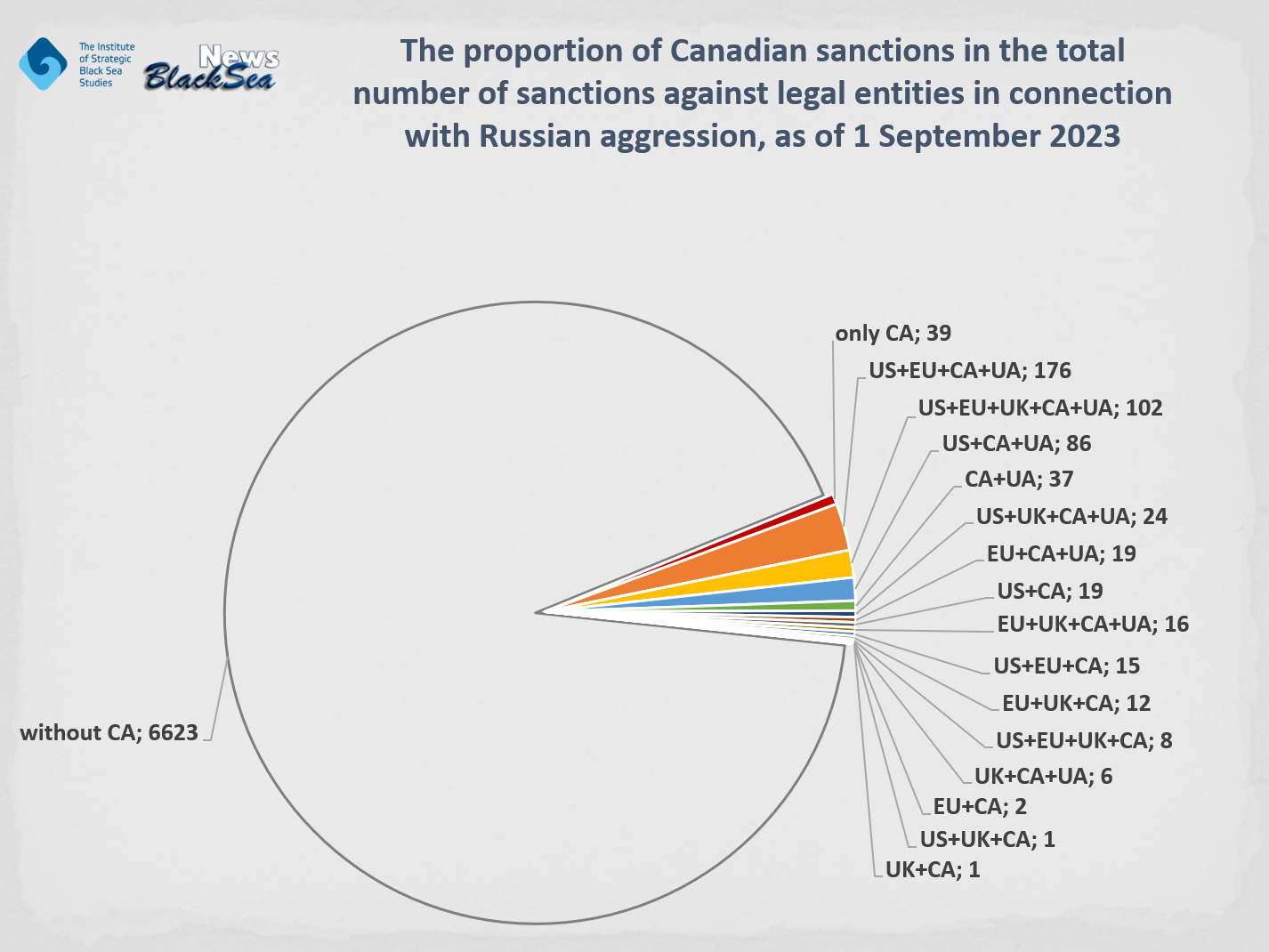
Figures 2 and 7 show that Canada could also increase significantly the number of sanctions against legal entities.
The scope of information by which a legal entity is identified in the Canadian sanctions list is limited to the name.
Unlike the Council Regulation (EU) No. 833/2014, for many companies on the Canadian list, more than one variant of the name is indicated. But, unfortunately, this is not enough for the effective implementation of sanctions.
For example, the Russian Cetelem Bank, which was placed on the Canadian sanctions list on 24 February 2022, actually dropped out of sight of Canadian legislation after it changed its name to Drive Click Bank in December 2022.
UK sanctions
The UK sanctions list consists of the EU lists that existed before 31 December 2020 and the persons against which UK sanctions were implemented after Brexit.
The “old” European sanctions were transformed under the Sanctions and Anti-Money Laundering Act 2018, and together with the new UK sanctions, they became part of the UK sanctions regime.
The database contains all legal entities placed on the UK sanctions list according to the regulations:
The database also includes several legal entities from the following regulations:
- Republic of Belarus (Sanctions) (EU Exit) Regulations 2019
- Iran (Sanctions) (Nuclear) (EU Exit) Regulations 2019
- Syria (Sanctions) (EU Exit) Regulations 2019
- Cyber (Sanctions) (EU Exit) Regulations 2020
- Chemical Weapons (Sanctions) (EU Exit) Regulations 2019
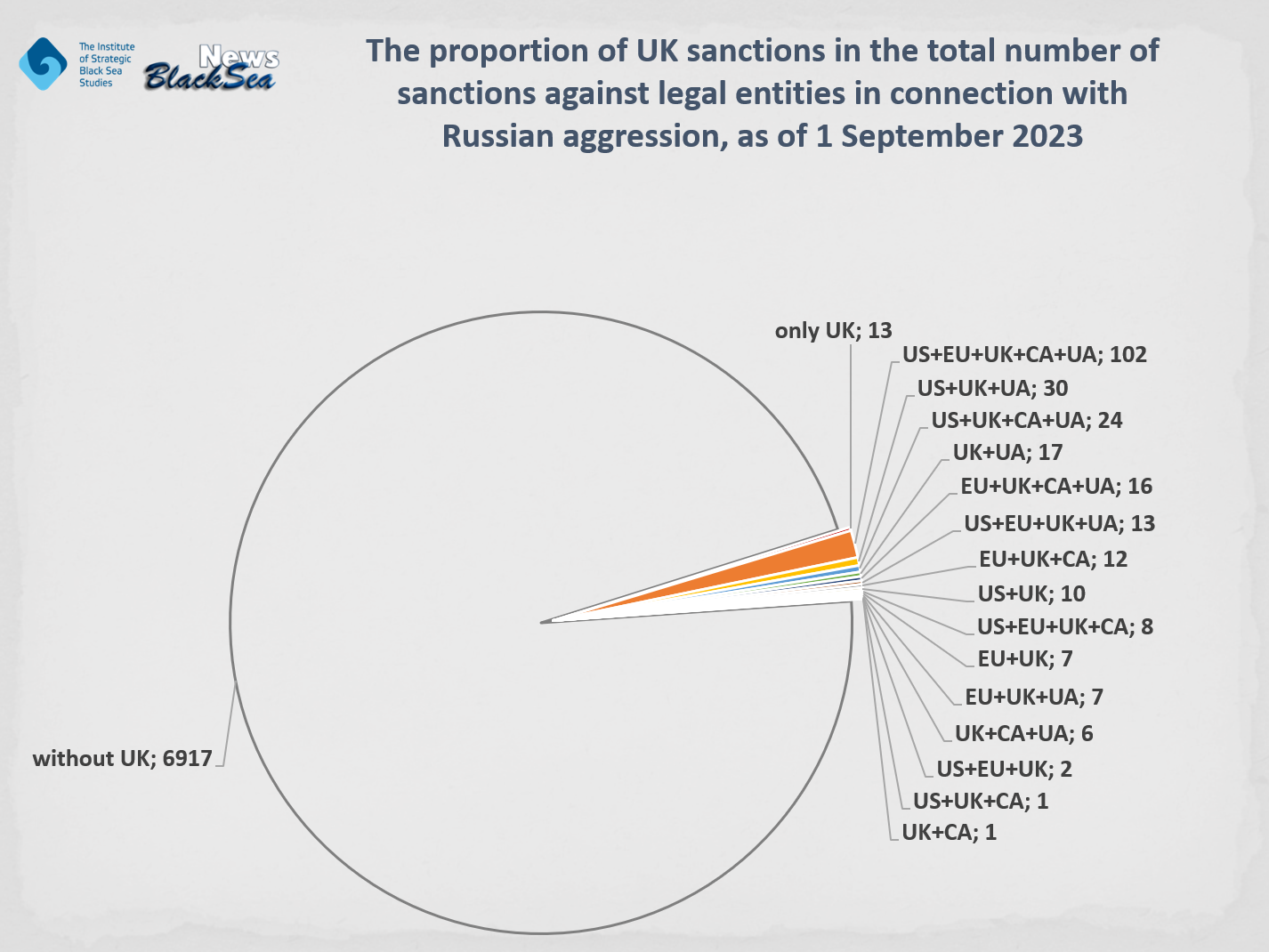
Despite the great role of the UK in supporting Ukraine in the fight against Russian aggression, the number of British sanctions against legal entities is still not impressive.
Linked entities
Legal entities associated with those under sanctions are a separate topic of research and investigation. Establishing connections is the first step on the way to proposals for new sanctions.
However, there are links that are plain to see. These are the so-called managing organisations. It is not uncommon that instead of a director, an enterprise is officially managed by another legal entity – a managing organisation.
If the managing organisation of an entity that is placed on sanctions lists is not under sanctions, it can freely operate in favour of the enterprise that is subject to sanctions.
As of 1 September 2023, at least 335 legal entities in the database had managing organisations.
Recently, more and more managing organisations have been added to sanctions lists, but, unfortunately, mostly only to the Ukrainian ones.
However, there are still legal entities that manage major enterprises under sanctions but are not subject to any sanctions themselves.
For example,
Concern Sozvezdie – a well-known developer and manufacturer of communication and electronic warfare systems and special equipment for the Armed Forces of the Russian Federation – since 10 March 2023, has been managed by Technoimpulse JSC (Registration ID: 1227700279850), which is not under sanctions.
KURGANMASHZAVOD PJSC, which is the only plant in Russia that specialises in the production of armoured infantry fighting vehicles and other vehicles based on them, since 29 June 2018, has been managed by JSC RT-Kurganmashzavod (Registration ID: 5117746037052), which is not subject to sanctions.
On 3 February 2020, Concern Uralvagonzavod JSC (Registration ID: 1187746432345), which was founded in 2018, became the managing organisation of Research and Production Corporation Uralvagonzavod JSC, a well-known tank manufacturer that is under all possible sanctions. The managing organisation is still not subject to sanctions.
Perspektiva LLC (Registration ID: 1197746305470), created in May 2019, manages two strategic enterprises. 1) Lipetsk Mechanical Plant LLC, which is one of the leading Russian manufacturers of modernised self-propelled towing vehicles for the S-300B4 anti-aircraft missile systems. 2) JSC Steel Research Institute, which is the leading Russian enterprise producing materials and structures for the protection of weapons and military equipment of the ground forces. It also develops complexes of armour, dynamic, and electromagnetic protection. The managing organisation is also not under sanctions.
Reorganisation, liquidation, and legal successors
It turns out that it is impossible to impose sanctions on an enterprise once and stop, because it changes.
A legal entity may be liquidated, its production facilities can be transferred to another enterprise, which is not under sanctions.
There are a lot of cases that require further investigation.
But there are also obvious things: when a liquidated legal entity has an official legal successor, the latter should be subject to sanctions “by default.”
For example,
Zaliv Shipyard in occupied Crimea had been under sanctions since 2016-2018. The legal entity was liquidated on 17 February 2021. Legal successor: B. Ye. Butoma Shipbuilding Plant JSC.
In fact, it’s just a reorganisation. B. Ye. Butoma Shipbuilding Plant JSC, which for some time acted as the “founder” of the stolen Ukrainian shipbuilding plant, merged with the plant under its own name. It continues to work for the Russian military-industrial complex.
Unfortunately, only Ukrainian sanctions are currently imposed on the enterprise.
Moscow-based Avia Group LLC was under US, Canadian, and Ukrainian sanctions. The legal entity was liquidated on 1 April 2021. Legal successor: Non-Public Joint-Stock Company Avia Group, which is subject only to Ukrainian sanctions.
It should be noted that today there are fewer legal successors that remain unnoticed. On the one hand, there is an appropriate response from the bodies responsible for imposing sanctions (currently, mainly Ukrainian ones). On the other hand, Russia began to hide more information, restricting access to part of official data. So there are more cases requiring investigation.
Thus, if the goal is at least to hinder the production of weapons in Russia, the processes of finding relevant legal entities and imposing sanctions on them should not stop.
What’s next
One of the conclusions of this analysis is that the sanctions of all partners in the “sanctions coalition” should be synchronised and their scope should be further extended.
It’s important to name and impose restrictions on every enterprise directly or indirectly related to the Russian military industry or the financing of the war. This will help prevent the production of modern weapons by the aggressor in the quantities necessary for waging war.
We see how much effort Russia is devoting today to creating schemes for circumventing sanctions.
Inventing a way to deceive neighbours or steal something is probably the most creative direction of Russia’s activity dating back to the USSR.
Unfortunately, there will always be a race when it comes to the speed of making decisions
- about restrictions / and on the other hand – designing bypass schemes;
- about combating some circumvention methods/ devising new ones.
Nevertheless, every uncovered scheme to circumvent sanctions means that the aggressor country has to spend additional time and money. And in the end, it still leads to a loss of quality and technologies in production.
Moreover, for an effective sanctions policy, it is necessary to have mechanisms and infrastructure for the introduction, implementation, and control of compliance with sanctions.
These involve additional organisations, people, and budget funds.
No, we are not naive. We can see how difficult it is to make many important decisions, we understand the political challenges that have to be overcome by those who are aware of the need to stop Russian aggression.
However, we can also see global trends.
The world will have to forget about the pre-war state of the global economy. For a long time. We will have to build a new global security system and, accordingly, new economic ties through losses and crises. Unfortunately, there is no alternative to that.
Sanctions are here to stay.
The hopes of those who expected that the “crisis” would somehow resolve itself haven’t been fulfilled. Instead, there is a growing understanding that the real crisis in the world is just beginning…
Sanctions – asset blocking, investment, export and other restrictions – will become one of the tools (unfortunately, not the worst) of communication between individual states and groups of states for a long time.
Therefore, each country should have appropriate bodies and procedures in place. It’s a race against the clock.
https://www.blackseanews.net/en/read/210554

